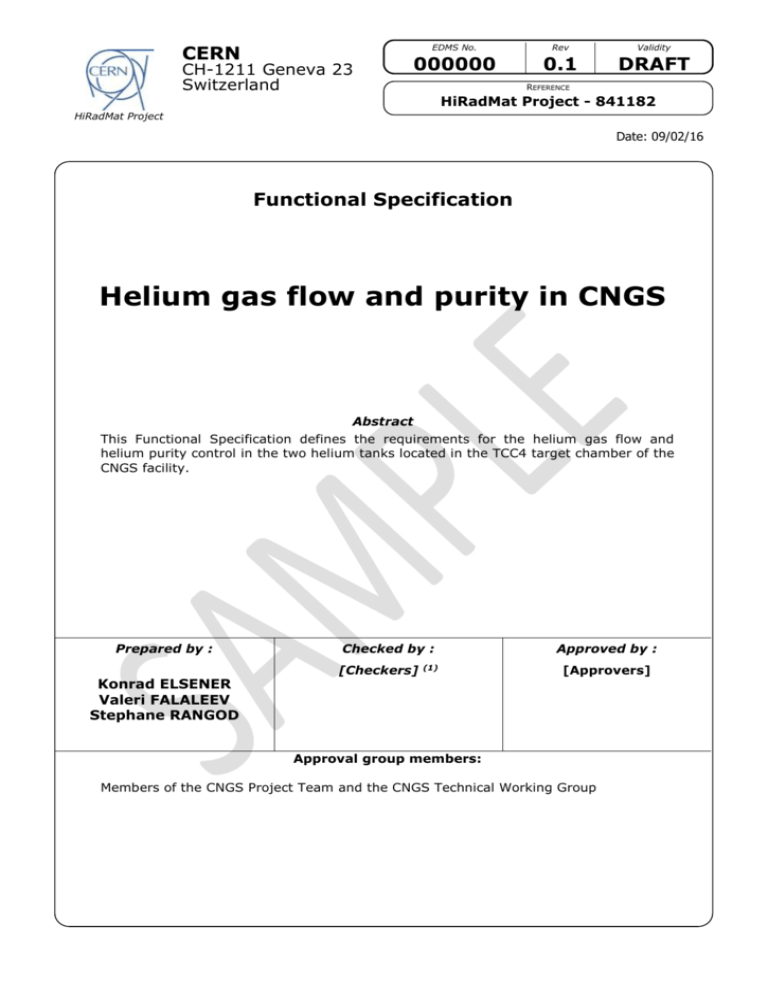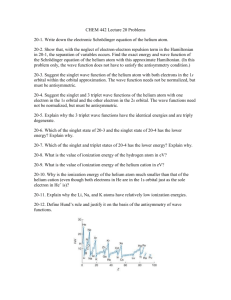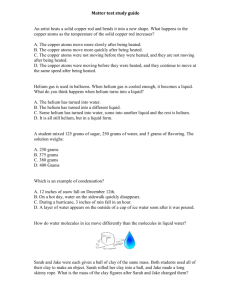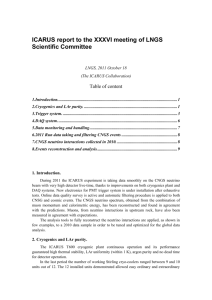HiRadMat_ProjectDocument_Example - Indico
advertisement

CERN CH-1211 Geneva 23 Switzerland EDMS No. Rev Validity 000000 0.1 DRAFT REFERENCE HiRadMat Project - 841182 HiRadMat Project Date: 09/02/16 Functional Specification Helium gas flow and purity in CNGS Abstract This Functional Specification defines the requirements for the helium gas flow and helium purity control in the two helium tanks located in the TCC4 target chamber of the CNGS facility. Prepared by : Konrad ELSENER Valeri FALALEEV Stephane RANGOD Checked by : [Checkers] (1) Approved by : [Approvers] Approval group members: Members of the CNGS Project Team and the CNGS Technical Working Group REFERENCE EDMS NO REV VALIDITY HiRadMat Project - 000000 000000 0.1 DRAFT Page 2 of 9 HISTORY OF CHANGES REV. NO. DATE PAGES DESCRIPTION OF CHANGES 2.0 2003-10-11 1-9 final version, including changes after approval process 1.0 2003-09-23 1-9 version for approval 0.2 draft 2003-08-29 1 - 10 includes comments by V. Falaleev and S. Rangod 0.1 draft 2003-08-20 1 - 10 Circulated as very early draft version REFERENCE EDMS NO REV VALIDITY HiRadMat Project - 000000 000000 0.1 DRAFT Page 3 of 9 TABLE OF CONTENTS [TITLE] ........................................................... ERROR! BOOKMARK NOT DEFINED. 1. 1.1 [LEVEL-1 TITLE] ...................................... ERROR! BOOKMARK NOT DEFINED. [LEVEL 2 TITLE] ................................. ERROR! BOOKMARK NOT DEFINED. 1.1.1 [level 3 title] ................................................Error! Bookmark not defined. REFERENCE EDMS NO REV VALIDITY HiRadMat Project - 000000 000000 0.1 DRAFT Page 4 of 9 1. SCOPE This Functional Specification summarizes the requirements on the helium gas flow and purity control in the helium tanks located in the target chamber TCC4 of the CNGS facility [1-5]. The CNGS Web pages should be consulted for the latest information on the CNGS layout and installations (http://cern.ch/cngs). 2. HELIUM GAS TANKS AND CNGS OPERATION 2.1 BRIEF DESCRIPTION OF THE CNGS NEUTRINO BEAM A schematic view of the main components of the CNGS facility is shown in Figure 1. Figure 1: Main components of the CNGS facility. The SPS proton beam is extracted at 400 GeV in LSS4 and guided over about 840 m through TT40/TT41 to the CNGS target station T40. The SPS protons colliding with the target produce secondary particles. The positively charged component of the secondary hadron beam is focused by magnetic lenses (horn and reflector) while the negatively charged particles are de-focussed into the shielding along the beam. The positive pions and kaons decay in flight into muonneutrinos and muons in a 1 km-long evacuated decay tube. Protons not interacting in the target, as well as hadrons which have not decayed, are absorbed in the hadron stopper. The muon beam from the decays is degraded in the hadron stopper but a high flux of muons still reaches the first muon detector chamber. Only the higher energy muons will reach the second muon detector chamber, separated from the first one by 67 m of rock. The neutrinos are travelling in the direction of Gran Sasso. 2.2 PARTICLE LOSSES - HELIUM OR VACUUM TANKS The intensity of the neutrino beam at Gran Sasso is given by the production rate of positively charged pions and kaons, and by the fraction of these secondary particles which are decaying while flying in the direction of Gran Sasso. REFERENCE EDMS NO REV VALIDITY HiRadMat Project - 000000 000000 0.1 DRAFT Page 5 of 9 Therefore, the performance of the CNGS facility in the region after the target is determined by two main factors: (1) The quality of the pion/kaon beam produced by the magnetic lenses (horn and reflector). This implies optimising the focusing of the pions/kaons produced into a parallel beam in direction of Gran Sasso. (2) The amount of material along the trajectories of the kaons and pions: reduce the losses of pions and kaons before they decay by limiting the nuclear interactions in material. In analogy to the solutions chosen at the WANF neutrino beam facility [8], material in the target chamber is reduced by inserting helium tanks between horn and reflector, as well as in the region downstream of the reflector. The main advantage of a helium over a vacuum tank is the reduced amount of material needed to build a tank operating at atmospheric pressure. Figure 2: Layout of the CNGS facility REFERENCE EDMS NO REV VALIDITY HiRadMat Project - 000000 000000 0.1 DRAFT Page 6 of 9 2.3 THE TARGET CHAMBER TCC4 Figure 2 gives a schematic view of the CNGS facility. The target chamber, called TCC4, is located at the end of the proton beam tunnel. It is about 120 metres long and houses the target station, the horn and reflector (focusing devices) and two helium tanks. The layout drawing of the target chamber, showing all the equipment, but also the shielding foreseen to be installed along the beam line, can be found at https://edms.cern.ch/document/310296 [see reference 6]. 2.4 THE HELIUM SYSTEM The two helium tanks are located in TCC4 and are connected in series by two pipes (“IN” and “RETURN”) to the existing building 930. No active equipment will be located in TCC4 or the service gallery TSG4 - building 930 will house a gas system and the controls equipment necessary to operate the system. A layout of building 930 showing the space reserved for the helium system is appended on page 9. 2.4.1 THE HELIUM TANKS IN TCC4 The exact start/end co-ordinates of the two helium tanks in TCC4 are evolving together with the detailed design of the equipment in this region of CNGS. Approximate dimensions of the helium tanks can however be given. The first helium tank, located between horn and reflector, is approximately 30 metres long. The first 6 metres are embedded in an iron collimator - in this part, the first helium tank has a diameter of 0.80 metres, for the rest of its length the diameter is 1.20 metres. The second helium tank is approximately 47 metres long and has a diameter of 1.20 metres. The two helium tanks are connected in series, with - in both tanks - the IN pipe connected near the highest and the OUT pipe connected near the lowest point of the tank. 2.4.2 THE HELIUM GAS SYSTEM IN BUILDING 930 The system will be connected via all-metal pipes from building 930 to TCC4, and back. The return helium will be lead through the instruments described below, then left into air. The helium gas system should consist of two racks of helium gas bottles, with an automatic (pneumatic) system to switch from one to the other a flow meter allowing a very large flow (for filling the tanks): 800 litres/hour a flow meter for standard operation with 10 mbar overpressure and a small flow: 140 litres/hour an oxygen metre on the “return” gas line to control the helium gas purity a small pump for the calibration of the oxygen metre with air 2 safety pressure bubblers, one in the “out” and the other in the “return” gas line, safety limit adjusted at 20 mbar an overpressure safety valve between bottles and bubblers OPTIONAL: an “on/off” flowmetre, indicating gas flow on the “return” gas line REFERENCE EDMS NO REV VALIDITY HiRadMat Project - 000000 000000 0.1 DRAFT Page 7 of 9 3. EXISTING EQUIPMENT FROM WANF The gas system as described in 2.4.2. exists and can be recuperated from WANF [7], with the exception of the optional “on/off” flow metre, which would need to be added. 4. REQUIREMENTS FOR THE HELIUM FLOW 4.1 GAS SUPPLY AND CONTROLS The supply of the “batteries” of helium gas bottles, connection to the gas system, regular control and exchange of bottles in time will be the responsibility of the GDS team in EST/LEA (see [8]). The existing automatic “bottle changer” has an output which allows to read which rack of bottles (A or B) is being used. This information must be read out and made available to the CNGS beam control system. Gas supply must be continuous, i.e. the helium gas flow must be available also in shutdown periods. 4.2 GAS FLOW CONTROL Information on the gas flow can be obtained - although indirectly - from the oxgen meter (see 5.1). OPTIONAL: The helium gas flow is to be controlled on the return line by a simple “yes/no” electronic flow metre. “Yes” corresponds to a gas flow of larger than 0.5 litres per minute, with an allowed error of 20%. 4.3 DATA ACQUISITION, DATA HANDLING, ALARMS See 5.3. below, for control of gas flow by using the oxygen meter. OPTIONAL: The status of the gas flow meter (“yes” or “no”) is to be checked every hour, and the status written into a log-file whenever there is a change of the status. If there is no change, the status is logged at 12:00 noon every day. A “low level” alarm must be created for the operators in the SPS control room, indicating that the helium gas flow has stopped and that action by a specialist is required. 5. REQUIREMENTS FOR THE HELIUM PURITY 5.1 OXYGEN METRE It is suggested that the existing oxygen metre from WANF is being re-used. 5.2 CALIBRATION OF OXYGEN METRE A calibration of the oxygen metre with air must be performed once per year. REFERENCE EDMS NO REV VALIDITY HiRadMat Project - 000000 000000 0.1 DRAFT Page 8 of 9 5.3 DATA ACQUISITION, DATA HANDLING, ALARMS The oxygen metre provides a voltage indicating the proportion of oxygen in the return helium gas line. This voltage is to be checked every hour, and helium purity written into a log-file whenever there is a change of more than 1%. If there is no change, the status is logged at 12:00 noon every day and written into a log-file. The reading is to be compared with a pre-defined, but changeable limit value (for example a level which corresponds to 95% helium purity), and a “low level” alarm must be created for the operators in the SPS control room if the oxygen level is above this pre-defined limit. The alarm must indicate that helium purity is bad and that action by a specialist is required. The information read from the oxygen metre must be made available to the CNGS beam control system. 6. SAFETY AND REGULATORY REQUIREMENTS The equipment used must meet the safety guidelines put forward by the CERN Technical Inspection and Safety Commission (TIS). TIS have issued safety documents in compliance with LHC-PM-QA-100 rev1.1, and the guidelines in these documents will be incorporated. 7. REFERENCES [1] K. Elsener Ed., The Cern Neutrino Beam to Gran Sasso (Conceptual Technical Design), CERN 98-02, INFN/AE-98/05, 1998. http://doc.cern.ch/cgi-bin/setlink?base=cernrep&categ=Yellow_Report&id=98-02 [2] R. Bailey et al., The CERN Neutrino Beam to Gran Sasso (NGS), CERN-SL-99-034DI, 1999, http://doc.cern.ch/archive/electronic/cern/preprints/sl/sl-99-034.pdf [3] A.E. Ball et al., CNGS: Update on Secondary Beam Layout, SL-Note-2000-063 EA, 2000, http://doc.cern.ch//archive/electronic/cern/others/sl/sl-note-2000-063.pdf [4] A.E. Ball et al., CNGS: Effects of Possible Alignment Errors, CERN-EP/2001-037, CERN-SL-2001-016 EA, 2001, http://doc.cern.ch/archive/electronic/cern/preprints/sl/sl-2001-016.pdf [5] M. Clement et al., Update of changes to CNGS layout and parameters, http://proj-cngs.web.cern.ch/proj-cngs/PDF%20files/CNGSupdate_note_final.pdf [6] Layout drawing of https://edms.cern.ch/document/310296 the target chamber area, [7] G. Acquistapace et al., “The West Area Neutrino Facility for CHORUS and NOMAD experiments (94-97 operations)”, http://doc.cern.ch/archive/electronic/cern/preprints/ecp/ecp-95-014.pdf [8] Meeting on CNGS helium gas system, 10 December 2002, summary notes see https://edms.cern.ch/file/366422/1/CNGS_helium_meeting_121202.pdf REFERENCE EDMS NO REV VALIDITY HiRadMat Project - 000000 000000 0.1 DRAFT Page 9 of 9







